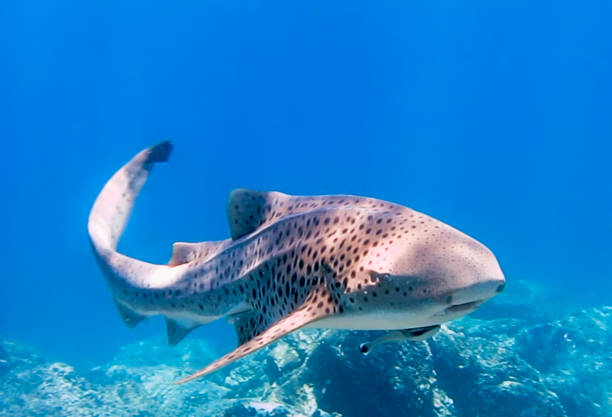ANIMAL: Zebra Shark Stegostoma fasciatum Type of Animal: Carpet Shark Habitat: Shallow/nearshore/coastal tropical/subtropical coral & rocky reefs, especially sandy areas & sandy flats-also found on coral & rubble bottoms. Have been seen in brackish & freshwater areas-not usually found deeper than 230 ft. Juveniles found in deeper areas as well as shallower habitats like mangroves (sometimes brackish) & seagrass beds. Location(s): Indo-Pacific Appearance: Cylindrical w/ large slightly flattened head & short blunt snout, adults yellow-brown to grayish-tan w/ dark brown spots, young dark brown w/ white spots/stripes (hence name zebra shark), fading to pale ventral surface, adults have longitudinal ridges. Becomes lighter w/ age. Food/Diet: Crabs, shrimp, snails, squid, small fish, sea snakes, sea urchins, bivalves, marine worms Status in Wild: Threatened Conservation: Breeding in aquariums, marine parks, & zoos Lifestyle: Schools of 10-50 individuals or solitary Additional Info: Called: Male Female Young-Pup Group-School/Shiver Weight: 45-65 lbs Gestation: 5 months Life Span: 15-20 years in captivity, 30 years in wild Body Length: Male: 5-9.8 ft Female: 5.6-8.2 ft Young: 2.5-3 ft Tail Length: Male: 2.5-4.9 ft Female: 2.8-4.1 ft Young: 1.25-1.5 ft Main predators of adults are larger shark species (especially tiger & bull sharks) & crocodiles. Large fish, sharks, & birds prey on young. Threatened due to fishing for meat, habitat degradation, water pollution, dynamiting, use of liver for medicinal purpose, accidental bycatch, shark-fin trade, coastal development, & marine debris. They’re active at night (nocturnal). Sometimes called leopard sharks due to adult pattern. They’re oviparous, releasing egg cases which anchor to bottom substrate w/ hair-like fibers. They’ll squeeze into narrow areas to find food. They use whisker-like barbels to find prey. During courtship, males bite on female’s pectoral fins & tail. Throughout breeding season, females can release up to 50 egg capsules, usually done in 4 batches. Only member of the family Stegostomatidae. Often swim in an eel-like manner. They tend to be slow-moving. Fun Fact(s): Combination of small mouth/thick throat/gill muscles come in handy to suck up prey. They’re very docile gentle animals. Due to differing appearance of young & adult animals-once thought to be different species. Parthenogenesis (development of unfertilized egg) has occurred on rare occasions in this species.

